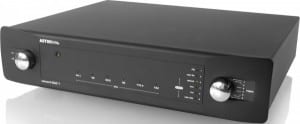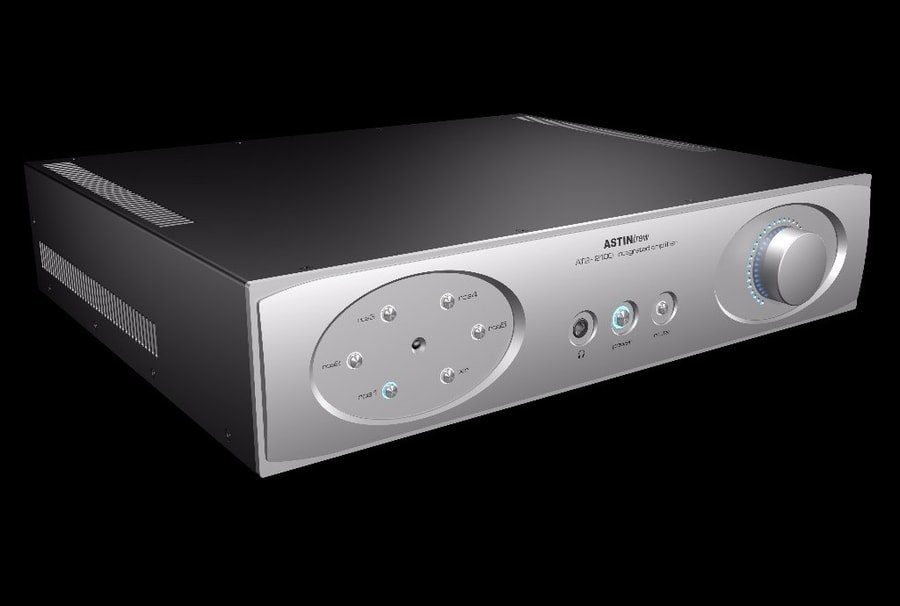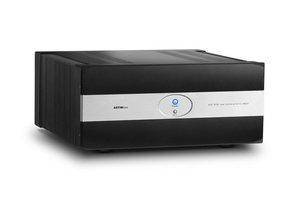This review comes from a personal experience with the Astin Trew Concord DAC1 I recently  borrowed from Tony Sallis at NuNu Distribution.
borrowed from Tony Sallis at NuNu Distribution.
I had been very impressed with the Totaldac D1 tube since reviewing it last year and subsequently bought it. However, I began to increasingly feel that I required a unit which being my main source needed to be more of a jack of all trades rather than strong in a handful of areas.
Having a system for reviewing other products cannot always be a system which is suited perfectly to the reviewer’s personal needs, or a particular flavour of music, as this can inherently cause a bottleneck when reviewing other products.
An amplifier strong in bass could be reflected on as being thin and light sounding in a system that doesn’t have a good balance. This can be a tricky situation for the reviewer.
Fortunately I like and listen to a good few genres of music which contrast hugely in their system demands and so I admit this was my initial intention, but as I thought more about the consideration of changes the above conclusions soon became just as important for me.
There was previous talk between myself and Michael Osbourne of Astin Trew a few months ago after the release of the Astin Trew Concord USB review with the Never Connected Power Supply about trying their Concord DAC. With it having the option for balanced XLR and tube buffered RCA outputs I could run both a solid state and valve amp simultaneously, just as I did with the Totaldac.
So I put in another enquiry to have a listen as soon as it was possible, a few other DACs I had tried over the past months still didn’t offer the ability to do many thing “right” instead of one or two things great for me and the option for straight transistor output or tube could well be a balance that would offer a take on the varying genres I wished to be able to cover.
Connectivity and Specs
I’ll go through an overview of what the Concord DAC has to offer connection-wise and run through  some specifications before I move on to the impact the sound had on me and convey the abilities which ultimately led to me purchasing one.
some specifications before I move on to the impact the sound had on me and convey the abilities which ultimately led to me purchasing one.
First up I’ll mention that the DAC is constructed in modular form, this allows for future upgrades, which an Astin Trew insider has informed me are being tweaked and finalised for a future release. A Signature version, or, by Astin Trew’s past form, maybe a Plus version?
There are 6 separately regulated supplies within the DAC and power sections are ‘firewalled’ from the data sections reducing EMI interference even further.
The casework is substantial and solid, very nicely fitted together with a wrap around – up and under chassis lid and sides. The coating on the chassis feels like it could be scratched fairly easy (not a test I wish to perform though) by the feel of it… it’s not rubber, but it is a compound specially formed to reduce resonances that the chassis may be subjected to.
The underside has four of Astin Trew’s proprietary feet fitted – a wide and shallow coned footer which is created from a special mix of compounded polymers.
So what do you get connection wise? A fair bit is the answer:
There are RCA tube buffered outputs, a pair of ECC82’s fulfill this task and are under run ensuring extra long lifespan.
Also included is a pair of XLR outputs, fully balanced and running in solid state. Both sets of outputs work simultaneously which for me allows me to have a constant connection to a solid state and valve amp without having to constantly change connections.
Two breakout cards are available when purchasing the DAC, an “either or decision”, to occupy the single slot on the board and rear panel. They is an Asyncronous USB or Firewire connection, capable of decoding files of up to 24/192 from a computer based source.
An I2S connection via HDMI, this is purely an input and Astin Trew’s Concord Transport due very soon will make full use of this connection for the optimum in digital data transfer.
There’s also the usual suspects, which you would expect on quality DAC these days- an optical, RCA and pleasantly a BNC as well as the RCA coax input. (Another great feature for me reviewing transports).
All inputs are selectable from the front right knob via relays rather than mechanical switches conserving the purity of the signal. The left hand knob is for power on and off.
Now the important bit
The Concord’s immediate sonic signature is one of complete textural musicality with an authorative bass. Undertones are completely fleshed out, rich and rhythmic. midrange clarity is unmistakably naturally presented with each note and vocal dropping through its range into a natural bodied reflection of the material played.
Higher frequencies and overtones are marvelously displayed – notes begin with accurate rendition  of edges, enter the musical performance with absolute clarity, explore the note naturally and decay with full expressive tonality and that for me encapsulates the full timbre and embodiment of the instrument.
of edges, enter the musical performance with absolute clarity, explore the note naturally and decay with full expressive tonality and that for me encapsulates the full timbre and embodiment of the instrument.
Dynamics from the Concord are pretty huge, not sharply explosive but more of a full bodied largeness in scale and presence, they are completely cohesive and focused in the fact the higher pitches of notes grab lower frequencies with both hands and lift their dynamic integration hand in hand with perfect timing.
Pronunciation of phrase is so well developed every spoken word has a clearly defined status due to the extremely impressive way in which the Concord renders texture.
There’s no fading of the pronunciation of words trailing off into a more defined edge of the next, there is clarity from start to finish in a completely sibilant free manner.
The pace and rhythm of the Concord is utterly engaging… fluid and encapsulating… driven with a bass force and tempo which is full of degrees of speed and layering that never gets too tight or dry. There is a controlling punch and extension which leaves other higher priced DACs in its wake, a real force to be reckoned with when listening to pacier beats.
On the flip side delicate passages have a fluid and liquid characteristic to them that is so involving, extended and smooth, with attention to flow that takes the listener to a level of commitment from the sound that intimate late night listening deserves, exploiting bandwidth with care.
By contrast to these points Kathryn Roberts silky tones sounded beautifully fluid on the ‘Ballad of Andy Jacobs’ precise, centred, never too large, but amply projected with a clarity of tone and focus.
Then on the other hand a strong electronic beat with fantastic dynamic range, impact and harmonic excitement during Route 94’s ‘My Love’ shows off the Astin Trews ability to hold strong, deep bass notes coupled with pace and rhythm. I found it increasingly more difficult to throw off the Concords balance…
Micheal Buble’s ‘All of Me’ is also dynamically rich, with the big band giving slam and impact which never clouded or muddied Buble’s lead vocal. Top end brass quality was undertoned with texture adding a “trueness” to the range the Concord was able to convey convincingly.
Gregory Porter’s jazzy vocal in contrasting tempo and varying instrument backing on his ‘Liquid Spirit’ album proved to me how subtle, contrasting and exciting the Concord can be and how much inner detail and rhythm it can put across in layers of three dimensional imaging without leaning to a specific characteristic, which could be deemed as DAC infused.
Soft rock through to harder grungier tracks from compilation albums such as the ‘Power Ballad’ albums quickly reinforced opinions that this DAC can manage a whole range of genres and that it’s abilities across the board were strong and competently even handed.
I have heard instruments and vocals done better, such as with the Lampizator Level 7, which has a depth and scale to acoustic and classical musical which is at the pinnacle of today’s offerings, but where the Lampizator triumphs for some musical genres it fails against the Concord on others.
In comparison to the Totaldac which I have owned for the best part of a year, the Totaldac sounds very beautiful and compares well across music types such as jazz and acoustic with the Concord. The Astintrew is slightly forward in the mids and the Totaldac slightly recessed or laid back, both swing each way of a stable mid-point in the depth of a system and comparing their vocal strength is also difficult and system dependent.
My own system is already a little forward in this department which is something I tune for as I enjoy a projected vocal, I like to here the singer really belt out the words, yet not overshadow the instruments in the music to a point where the artist sounds too forward.
I spent a great deal of time comparing the vocal contrasts between the Totaldac and that of the Astin Trew, both use tube outputs (both just on the single ended outputs). The Astin Trew with its tube buffered output and the Totaldac has a full valve output.
The Totaldac has a wonderful refinement yet lacks drive, punch and excitement but has a seductive sound. The Astin Trew swaps absolute refinement for a vibrancy and excitement. Detail is still magnificent, but displayed very differently. There is an unmistakeable clarity, pace and rhythm to the sound and being buffered still gives a truly musical substance to the music and is just so involving, it leaves one not necessarily admiring the sound, but getting more involved and invigorated by it.
I had a chance to listen to the XLR outputs vs the RCA outputs when I had a Roksan Caspian M2 integrated here recently (my own transistor amp which can accommodate both connection types is away to have some work done).
Both connections do sound different as the RCA output is buffered and the XLR isn’t, there’s not a favourite in my mind, just a different take on the same core sound. There’s an arguably cleaner, more dynamic nature to the straight transistor and a richer, slightly rounder character to the midrange of the single-ended output with a little less bass extension and firmness. The top end is also slightly more rounded and has a little less air through the RCA outputs, but it’s really down to personal preference and not by any means better or worse.
I will be intrigued to compare the differences even further and more in depth with my Kavent when it comes back.
So in Conclusion
After demoing a fair few DACs over the past few months and as I stated at the beginning of this review, I did purchase the Concord and I think that time will prove that the decision was a correct one for me with my musical preferences, system needs and wants for connectivity having all been ticked.
Of course I would recommend it, that goes without saying. The only reasons I can summarise is that it’s ability to reproduce so much music so well outweighs any DAC I have heard which can do one or two genres better… and from what I’ve heard upto and around £8k there aren’t many.
Some seriously technically minded and serious music enthusiasts have had their fingers and thoughts involved in the final tweaked production model of this DAC and it shows. Great time and attention has gone into voicing the product. An ability to do all things well and nothing short of that fact, is the Concord’s calling card.
I keep saying it does all things well, but I would like to emphasise it’s better than just well done, the Astin Trew Concord does everything great and then some. In many cases it has punched above its weight. I can say confidently that I don’t see the product being one that falls into a category of system synergy, it simply falls into the category of outstandingly diverse and musically competent!
Build quality – 8.3/10
Sound Quality – 9/10
Value for Money – 8.7/10
Overall – 8.6/10
Price at time of review – £3,760
DAC with USB input – £4,100 (as reviewed)
DAC with Firewire input – £4,200
Highly recommend for being able to perform many genres fantastically and in some cases even better than one trick ponies that cost more money… and because I know own one of course!
Having achieved an overall score in excess of 8.5 the Astin Trew Concord DAC1 now has the opportunity for a second review to see if it will score 8.5 again and get the Hifi Pig Outstanding Product Award
Author – Danny Worth





















































































































































































You must be logged in to leave a reply.